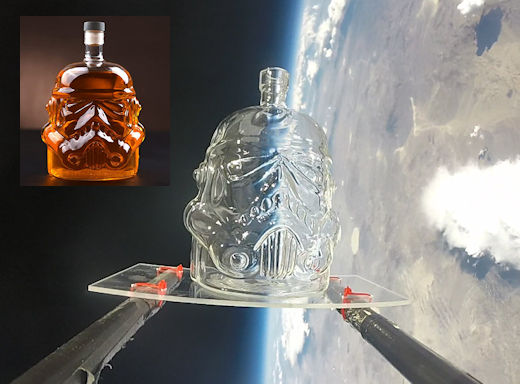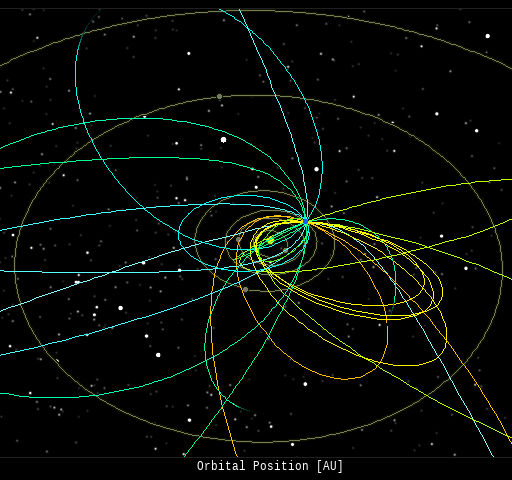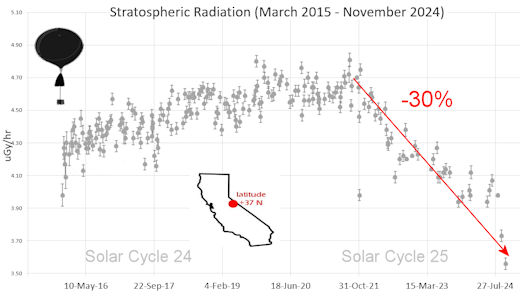 |
| |

SPACE WEATHER
NOAA Forecasts |
|
Updated at: 2025 Oct 31 2200 UTC
FLARE |
0-24
hr |
24-48
hr |
CLASS M |
05
% |
10
% |
CLASS X |
01
% |
01
% |
 Geomagnetic Storms:
Geomagnetic Storms:
Probabilities for significant
disturbances in Earth's magnetic field are given for three activity levels: active, minor
storm, severe
storm
Updated at: 2025 Oct 31 2200 UTC
Mid-latitudes
|
0-24
hr |
24-48
hr |
ACTIVE |
35
% |
35
% |
MINOR |
20
% |
20
% |
SEVERE |
05
% |
05
% |
High latitudes
|
0-24
hr |
24-48
hr |
ACTIVE |
10
% |
10
% |
MINOR |
30
% |
30
% |
SEVERE |
50
% |
50
% |
|
|
|
 |
|
|
|
| |
|
|
|
| |
This is an AI Free Zone: Text created by Large Language Models is spreading across the Internet. It's well-written, but frequently inaccurate. If you find a mistake on Spaceweather.com, rest assured it was made by a real human being.
|
|
|
HALLOWEEN FIREBALLS ARE SCARIER THAN WE THOUGHT: Right now, Earth is passing through a stream of debris from Comet Encke--source of the annual "Halloween Fireballs." These slow-moving meteors streak from the constellation Taurus during weeks around Halloween. If you see one tonight, it could foreshadow something genuinely scary. New peer-reviewed research suggests that hazardous Tunguska-class objects may be lurking within the stream--and Earth could run into one in the 2030s. Happy Halloween?
RAPID BRIGHTENING OF COMET 3I/ATLAS: Spacecraft monitoring the sun witnessed a dramatic surge in the brightness of Comet 3I/ATLAS as it plunged toward its Oct. 29th perihelion. Qicheng Zhang (Lowell Observatory) and Karl Battams (U.S. Naval Research Laboratory) reported the phenomenon in a preprint submitted to the Astrophysical Journal Letters on Oct. 28th.
"The reason for 3I’s rapid brightening, which far exceeds the brightening rate of most Oort cloud comets, remains unclear," the authors say.

While Earth-based telescopes lost sight of the comet during its close approach to the sun, coronagraphs on spacecraft like STEREO-A, SOHO, and NOAA’s GOES-19 satellite never stopped watching. The composite image, above, shows how the comet looked to these instruments.
NOAA’s CCOR-1 coronagraph did the best job resolving the comet, showing a 4-arcminute-wide coma (atmosphere), while SOHO's C3 coronagraph collected the best color data, revealing the comet to be bluer than the sun. The blue color hints that glowing gas, not dust, now dominates its brightness.
 Zhang and Battams analyzed coronagraph data from September and October. They found that 3I/ATLAS has been increasing in brightness as the 7.5th power of decreasing distance from the sun--twice as fast as it was brightening earlier this year. This might be caused by a surge in water sublimating from the comet's core, they speculated in the paper. Zhang and Battams analyzed coronagraph data from September and October. They found that 3I/ATLAS has been increasing in brightness as the 7.5th power of decreasing distance from the sun--twice as fast as it was brightening earlier this year. This might be caused by a surge in water sublimating from the comet's core, they speculated in the paper.
"Our cursory analysis of this data indicates the comet will likely emerge from solar conjunction considerably brighter than when it entered," they say.
This bodes well for the future. Europe's JUICE spacecraft will encounter the comet for a closer look starting Nov. 2nd. Its instruments will benefit from the increased brightness. Moreover, telescopes on Earth will regain the ability to image 3I/ATLAS in late November and December when the interstellar object fully emerges from the glare of the sun.
What will they see? Stay tuned for updates!
Realtime Space Weather Photo Gallery
Free: Spaceweather.com Newsletter
DRINK LIKE A STORM TROOPER: It's the perfect gift for a Star Wars fan--a Storm Trooper Whiskey Decanter. On Oct. 10th, it hitched a ride onboard a cosmic ray research balloon floating 106,066 feet above the Sierra Nevada mountains of central California:

You can have it for $124.95. The 750 ml decanter comes with a greeting card showing the item in flight, and telling the story of its journey to the stratosphere and back again. All purchases from the Earth to Sky Store help pay the helium bill for our student ballooning program.
Far Out Gifts: Earth to Sky Store
All sales support hands-on STEM education
Realtime Aurora Photo Gallery
Free: Spaceweather.com Newsletter
Every night, a network
of NASA
all-sky cameras scans the skies above the United
States for meteoritic fireballs. Automated software
maintained by NASA's Meteoroid Environment Office
calculates their orbits, velocity, penetration depth
in Earth's atmosphere and many other characteristics.
Daily results are presented here on Spaceweather.com.
On Oct 31, 2025, the network reported 18 fireballs.
(13 sporadics, 3 Northern Taurids, 1 Orionid, 1 omicron Eridanid)

In this diagram of the inner solar system, all of the fireball orbits intersect at a single point--Earth. The orbits are color-coded by velocity, from slow (red) to fast (blue).
[Larger image] [movies]
Potentially Hazardous Asteroids ( PHAs)
are space rocks larger than approximately 100m that
can come closer to Earth than 0.05 AU. None of the
known PHAs is on a collision course with our planet,
although astronomers are finding new
ones all the time.
On October 31, 2025 there were 2349 potentially hazardous asteroids.
 |
Recent
& Upcoming Earth-asteroid encounters:
| Asteroid |
Date(UT) |
Miss Distance |
Velocity (km/s) |
Diameter (m) |
| 2025 UE8 |
2025-Oct-26 |
3.9 LD |
9.9 |
13 |
| 2025 UV9 |
2025-Oct-26 |
1.6 LD |
13.1 |
10 |
| 2025 UU1 |
2025-Oct-26 |
16.2 LD |
13.3 |
27 |
| 2025 UV2 |
2025-Oct-26 |
14.6 LD |
7.7 |
12 |
| 2025 UM7 |
2025-Oct-26 |
4 LD |
14.8 |
13 |
| 2009 HC |
2025-Oct-26 |
8.6 LD |
4.2 |
42 |
| 2025 UU7 |
2025-Oct-26 |
6.6 LD |
17.5 |
24 |
| 2025 UJ2 |
2025-Oct-26 |
18.9 LD |
14.5 |
51 |
| 2025 UE6 |
2025-Oct-26 |
16.6 LD |
10.7 |
28 |
| 2025 UZ7 |
2025-Oct-27 |
0.3 LD |
8.7 |
4 |
| 2025 UF3 |
2025-Oct-27 |
6.2 LD |
3.2 |
13 |
| 2025 UH6 |
2025-Oct-27 |
2.4 LD |
8.5 |
12 |
| 2025 UK7 |
2025-Oct-27 |
18.2 LD |
12.5 |
17 |
| 2025 UO9 |
2025-Oct-27 |
8.5 LD |
7.2 |
15 |
| 434196 |
2025-Oct-27 |
17.4 LD |
10.9 |
171 |
| 2025 UM8 |
2025-Oct-28 |
7.3 LD |
14.8 |
36 |
| 2025 UH11 |
2025-Oct-28 |
3.3 LD |
14 |
13 |
| 2025 UD9 |
2025-Oct-28 |
0.6 LD |
10.4 |
13 |
| 2025 UC8 |
2025-Oct-28 |
1.3 LD |
8.1 |
10 |
| 2025 UD7 |
2025-Oct-28 |
5.8 LD |
8.6 |
12 |
| 2025 UQ1 |
2025-Oct-28 |
10.4 LD |
5.8 |
10 |
| 2025 UV7 |
2025-Oct-29 |
0.3 LD |
9.6 |
4 |
| 2025 UG11 |
2025-Oct-29 |
2.4 LD |
6 |
7 |
| 2025 UD5 |
2025-Oct-29 |
2.5 LD |
3.2 |
20 |
| 2025 UH2 |
2025-Oct-29 |
19.3 LD |
8.9 |
29 |
| 2025 UV5 |
2025-Oct-29 |
4.3 LD |
5.6 |
18 |
| 2025 UF9 |
2025-Oct-29 |
0.8 LD |
19.7 |
37 |
| 2025 UF5 |
2025-Oct-29 |
2 LD |
3 |
10 |
| 2025 UX7 |
2025-Oct-29 |
0.9 LD |
20 |
7 |
| 2025 UP7 |
2025-Oct-29 |
4 LD |
13.8 |
13 |
| 2025 UL2 |
2025-Oct-29 |
3.9 LD |
12.4 |
22 |
| 2025 UC11 |
2025-Oct-30 |
0 LD |
11.4 |
1 |
| 2025 UF4 |
2025-Oct-30 |
15.3 LD |
10.2 |
78 |
| 2025 UE9 |
2025-Oct-30 |
3.4 LD |
24.5 |
18 |
| 2025 UK9 |
2025-Oct-30 |
1.1 LD |
7.8 |
4 |
| 2025 UH7 |
2025-Oct-31 |
2.2 LD |
7.8 |
8 |
| 2025 UN9 |
2025-Oct-31 |
7.2 LD |
2.4 |
8 |
| 2025 UO7 |
2025-Nov-01 |
8 LD |
7.6 |
17 |
| 2025 UU9 |
2025-Nov-02 |
14.9 LD |
4.4 |
14 |
| 2025 TP11 |
2025-Nov-02 |
12 LD |
8.4 |
35 |
| 2005 EZ223 |
2025-Nov-03 |
15.6 LD |
12.9 |
78 |
| 2023 VK6 |
2025-Nov-03 |
7.6 LD |
9.6 |
15 |
| 2025 TB12 |
2025-Nov-04 |
7.3 LD |
6.3 |
19 |
| 2025 UO8 |
2025-Nov-06 |
17.9 LD |
7.2 |
33 |
| 2025 UL4 |
2025-Nov-07 |
16.9 LD |
8.3 |
25 |
| 2021 VQ10 |
2025-Nov-08 |
9 LD |
15 |
13 |
| 2019 UH7 |
2025-Nov-08 |
13.3 LD |
5.8 |
11 |
| 2018 KC |
2025-Nov-09 |
16 LD |
9.3 |
11 |
| 2017 WG14 |
2025-Nov-09 |
16.7 LD |
11.7 |
45 |
| 2020 VK4 |
2025-Nov-10 |
16.4 LD |
3.8 |
9 |
| 2012 VC26 |
2025-Nov-11 |
13.3 LD |
6.4 |
6 |
| 2025 UP9 |
2025-Nov-11 |
18.1 LD |
14 |
46 |
| 2019 VL5 |
2025-Nov-14 |
14.7 LD |
9.1 |
24 |
| 2022 FG4 |
2025-Nov-17 |
18.7 LD |
22.2 |
105 |
| 3361 |
2025-Nov-19 |
14.8 LD |
9.1 |
439 |
| 2013 NJ4 |
2025-Nov-20 |
12.6 LD |
6.4 |
12 |
| 2021 WR |
2025-Nov-22 |
19.3 LD |
10 |
31 |
| 516155 |
2025-Nov-24 |
12.5 LD |
16.7 |
338 |
| 2020 WM |
2025-Nov-24 |
17.4 LD |
11.8 |
36 |
| 2019 UT6 |
2025-Nov-25 |
6.2 LD |
12.6 |
146 |
| 2018 WG2 |
2025-Nov-27 |
13.5 LD |
7.5 |
3 |
| 2007 VM184 |
2025-Dec-01 |
13.1 LD |
20 |
219 |
| 2018 WC2 |
2025-Dec-03 |
9.8 LD |
8.9 |
36 |
| 2025 UF10 |
2025-Dec-04 |
14.7 LD |
13.3 |
135 |
| 2021 JE1 |
2025-Dec-08 |
13.5 LD |
7.1 |
16 |
| 2019 XN3 |
2025-Dec-10 |
5.7 LD |
3.6 |
15 |
| 1999 SF10 |
2025-Dec-10 |
8.2 LD |
4.4 |
46 |
| 2016 YH |
2025-Dec-13 |
6.8 LD |
8.9 |
28 |
| 2025 TZ |
2025-Dec-15 |
17.8 LD |
6.2 |
53 |
| 2015 XX168 |
2025-Dec-18 |
4.7 LD |
11.6 |
27 |
| 2010 WR7 |
2025-Dec-20 |
19.5 LD |
8.3 |
71 |
| 2021 AB1 |
2025-Dec-28 |
10.2 LD |
12.3 |
16 |
Notes: LD means
"Lunar Distance." 1 LD = 384,401 km, the distance
between Earth and the Moon. 1 LD also equals 0.00256
AU.
| |
Cosmic Rays in the Atmosphere |
SPACE WEATHER BALLOON DATA: Almost once a week, Spaceweather.com and the students of Earth to Sky Calculus fly space weather balloons to the stratosphere over California. These balloons are equipped with sensors that detect secondary cosmic rays, a form of radiation from space that can penetrate all the way down to Earth's surface. Our monitoring program has been underway without interruption for 10 years, resulting in a unique dataset of in situ atmospheric measurements.
Latest results (Nov. 2024): Atmospheric radiation is sharply decreasing in 2024. Our latest measurements in November registered a 10-year low:

What's going on? Ironically, the radiation drop is caused by increasing solar activity. Solar Cycle 25 has roared to life faster than forecasters expected. The sun's strengthening and increasingly tangled magnetic field repels cosmic rays from deep space. In addition, solar coronal mass ejections (CMEs) sweep aside cosmic rays, causing sharp reductions called "Forbush Decreases." The two effects blend together to bring daily radiation levels down.
.Who cares? Cosmic rays are a surprisingly "down to Earth" form of space weather. They can alter the chemistry of the atmosphere, trigger lightning, and penetrate commercial airplanes. According to a study from the Harvard T.H. Chan school of public health, crews of aircraft have higher rates of cancer than the general population. The researchers listed cosmic rays, irregular sleep habits, and chemical contaminants as leading risk factors. A number of controversial studies (#1, #2, #3, #4) go even further, linking cosmic rays with cardiac arrhythmias and sudden cardiac death.
Technical notes: The radiation sensors onboard our helium balloons detect X-rays and gamma-rays in the energy range 10 keV to 20 MeV. These energies span the range of medical X-ray machines and airport security scanners.
Data points in the graph labeled "Stratospheric Radiation" correspond to the peak of the Regener-Pfotzer maximum, which lies about 67,000 feet above central California. When cosmic rays crash into Earth's atmosphere, they produce a spray of secondary particles that is most intense at the entrance to the stratosphere. Physicists Eric Regener and Georg Pfotzer discovered the maximum using balloons in the 1930s and it is what we are measuring today.
| |
The
official U.S. government space weather bureau |
| |
The
first place to look for information about sundogs,
pillars, rainbows and related phenomena. |
| |
Researchers
call it a "Hubble for the sun." SDO
is the most advanced solar observatory ever. |
| |
3D
views of the sun from NASA's Solar and Terrestrial
Relations Observatory |
| |
Realtime
and archival images of the Sun from SOHO. |
| |
information about sunspots based on the latest NOAA/USAF Active Region Summary |
| |
current counts of failed and deployed Starlink satellites from Jonathan's Space Page. See also, all satellite statistics. |
| |
Authoritative predictions of space junk and satellite re-entries |
| |
from
the NOAA Space Environment Center |
| |
fun to read, but should be taken with a grain of salt! Forecasts looking ahead more than a few days are often wrong. |
| |
from the NOAA Space Environment Center |
| |
the
underlying science of space weather |
 |
Got a chipped or cracked windshield that prevents you from seeing space weather events while driving? Get windshield replacement from SR Windows & Glass with free mobile auto glass service anywhere in the Phoenix area. |
| |
These links help Spaceweather.com stay online. Thank you to our supporters! |
|
|
| |
|
|
|
|
 |
|
 |

 |
©2021 Spaceweather.com. All rights reserved. This site is penned daily by Dr. Tony Phillips. |